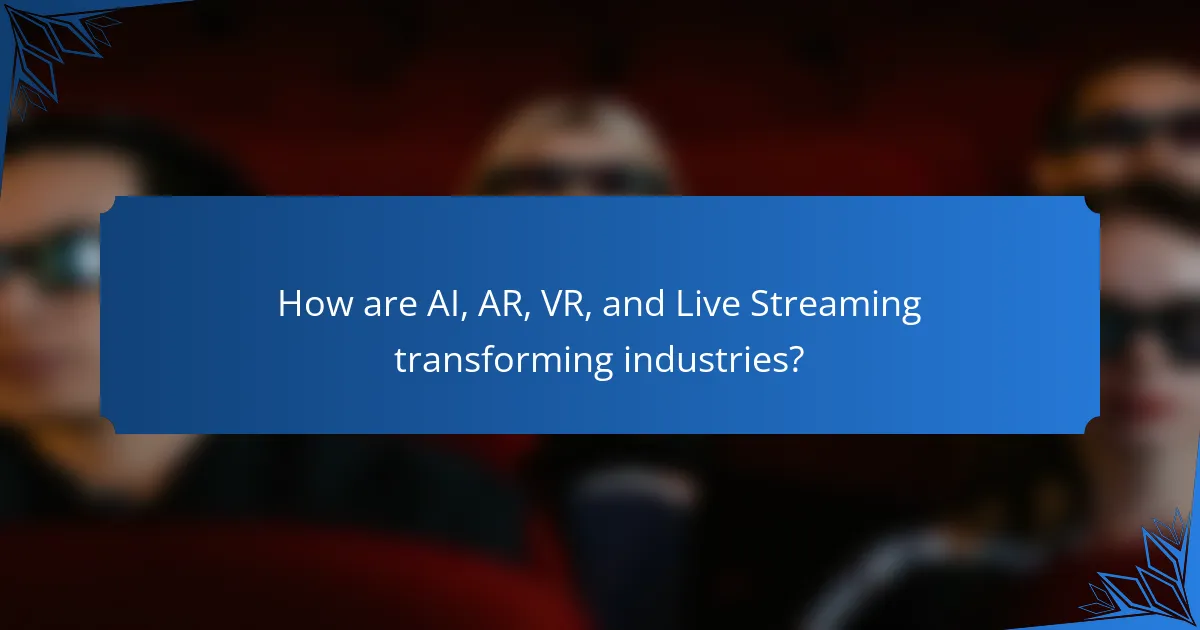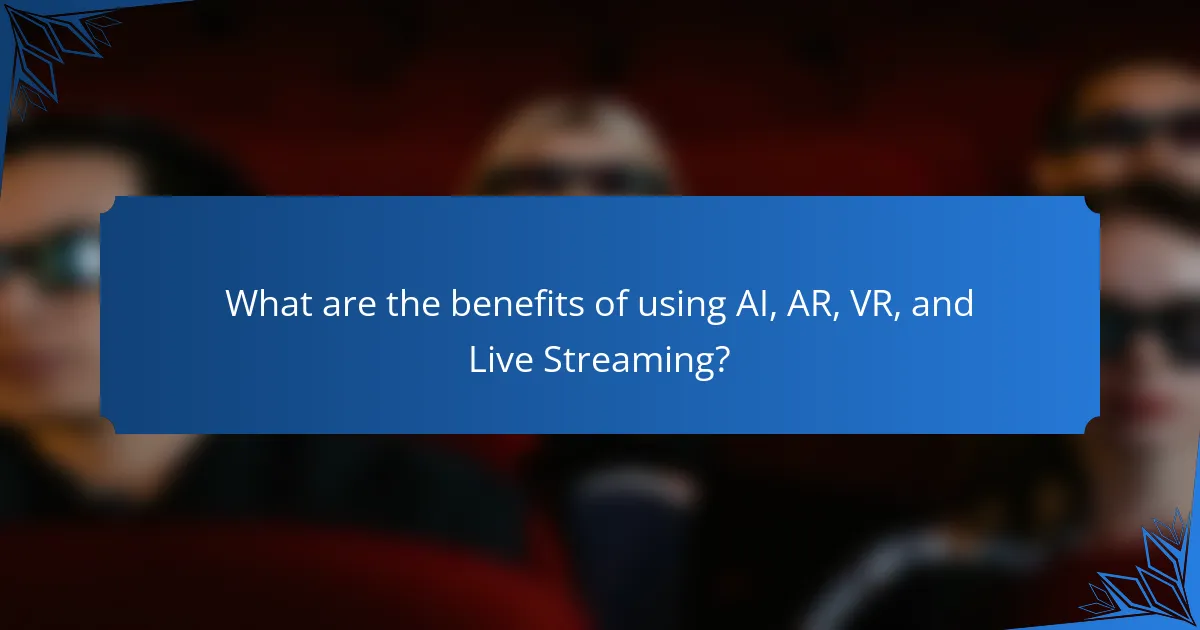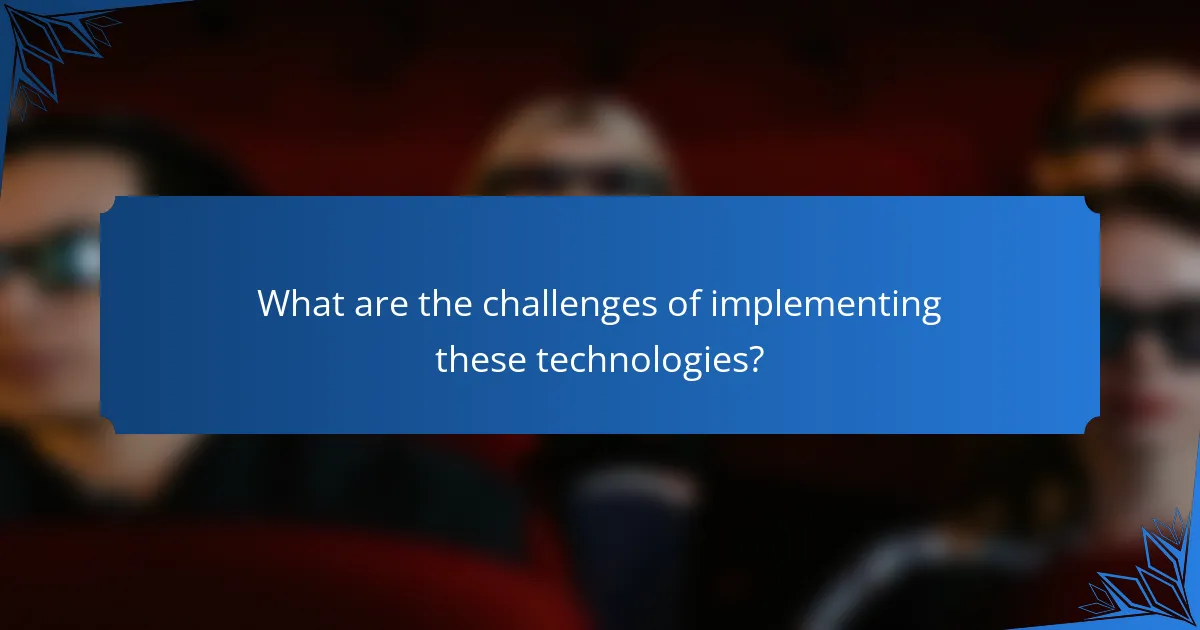Emerging technologies such as AI, AR, VR, and live streaming are transforming industries by enhancing operational efficiency and user engagement. These innovations not only create immersive experiences but also enable businesses to better understand customer behaviors and optimize their services. However, the integration of these technologies comes with challenges, including high costs and the need for specialized expertise.

How are AI, AR, VR, and Live Streaming transforming industries?
AI, AR, VR, and live streaming are revolutionizing various sectors by enhancing efficiency, improving user engagement, and creating immersive experiences. These technologies are reshaping how businesses operate, interact with customers, and deliver services.
AI in healthcare
AI is significantly impacting healthcare by enabling more accurate diagnostics and personalized treatment plans. Machine learning algorithms analyze patient data to identify patterns, predict outcomes, and assist in clinical decision-making.
For example, AI tools can help radiologists detect anomalies in medical images with high precision, often outperforming human counterparts. Additionally, AI-driven chatbots provide patients with immediate support, improving access to care.
AR in retail
Augmented reality (AR) is transforming retail by enhancing the shopping experience through virtual try-ons and interactive displays. Customers can visualize products in their own environment before making a purchase, leading to more informed decisions.
Retailers like IKEA use AR apps to allow customers to see how furniture fits in their homes. This technology not only boosts customer satisfaction but also reduces return rates, benefiting both consumers and businesses.
VR in education
Virtual reality (VR) is reshaping education by providing immersive learning experiences that engage students in ways traditional methods cannot. VR simulations allow learners to explore complex concepts in a safe, controlled environment.
For instance, medical students can practice surgeries in a virtual setting, gaining hands-on experience without the risks associated with real-life procedures. This technology fosters deeper understanding and retention of knowledge.
Live Streaming in entertainment
Live streaming is revolutionizing the entertainment industry by enabling real-time interaction between creators and audiences. Platforms like Twitch and YouTube Live allow content creators to engage with fans through live chats and instant feedback.
This format not only enhances viewer engagement but also opens new revenue streams through subscriptions and donations. As a result, many artists and entertainers are leveraging live streaming to build their brands and connect with audiences globally.

What are the benefits of using AI, AR, VR, and Live Streaming?
AI, AR, VR, and live streaming offer significant advantages in enhancing user experience, optimizing data insights, reducing marketing costs, and creating immersive environments. These technologies can transform how businesses interact with customers and analyze their behaviors.
Enhanced user engagement
AI, AR, VR, and live streaming significantly boost user engagement by providing interactive and personalized experiences. For instance, AR applications allow users to visualize products in their own environment before making a purchase, increasing the likelihood of conversion.
Live streaming enables real-time interaction between brands and audiences, fostering a sense of community and immediacy. This can lead to higher viewer retention rates and increased brand loyalty.
Improved data analysis
These technologies facilitate better data collection and analysis, allowing businesses to understand customer preferences and behaviors more accurately. AI algorithms can analyze vast amounts of data to identify trends and patterns that inform strategic decisions.
For example, VR experiences can track user movements and interactions, providing valuable insights into user engagement levels. This data can be used to refine marketing strategies and product offerings.
Cost-effective marketing
Utilizing AI, AR, VR, and live streaming can lead to more cost-effective marketing strategies. By creating engaging content that resonates with audiences, businesses can reduce their reliance on traditional advertising methods, which often involve higher costs.
For instance, a well-executed live streaming event can reach thousands of viewers at a fraction of the cost of a physical event. Additionally, AR campaigns can generate buzz without the need for extensive physical materials.
Immersive experiences
These technologies create immersive experiences that captivate users and enhance brand storytelling. VR, for example, allows users to step into a virtual world, making them feel as if they are part of the narrative.
AR can overlay digital information onto the real world, enriching the user’s environment and providing context that enhances understanding. This level of immersion can lead to stronger emotional connections with the brand.

What are the challenges of implementing these technologies?
Implementing emerging technologies like AI, AR, VR, and live streaming presents several challenges, including high initial investments, the need for technical expertise, and data privacy concerns. Organizations must navigate these hurdles to successfully integrate these technologies into their operations.
High initial investment
The cost of adopting emerging technologies can be substantial, often requiring significant upfront capital. For instance, setting up AR or VR systems may involve purchasing specialized hardware and software, which can range from thousands to tens of thousands of dollars depending on the scale and complexity.
Organizations should consider the long-term return on investment (ROI) when evaluating these costs. It may be beneficial to start with pilot projects to assess effectiveness before committing to larger expenditures. Additionally, exploring financing options or partnerships can help mitigate initial financial burdens.
Technical expertise required
Implementing technologies like AI, AR, and VR necessitates a skilled workforce familiar with these tools. Companies often face a shortage of qualified professionals who can design, develop, and maintain these systems, which can slow down deployment and increase costs.
Investing in training for existing staff or collaborating with external experts can bridge this skills gap. Organizations might also consider leveraging user-friendly platforms that reduce the technical barrier for entry, enabling broader team participation in technology deployment.
Data privacy concerns
Data privacy is a significant challenge when implementing technologies that rely on user data, such as AI and live streaming. Organizations must ensure compliance with regulations like GDPR in Europe or CCPA in California, which mandate strict data handling and user consent protocols.
To address these concerns, companies should conduct thorough risk assessments and implement robust data protection measures. Regular audits and transparent privacy policies can help build trust with users while ensuring compliance with legal standards.

How to choose the right technology for your business?
Selecting the right technology for your business involves understanding your specific needs, the preferences of your target audience, and the potential for future growth. Each technology, whether AI, AR, VR, or live streaming, offers unique benefits and challenges that must align with your strategic goals.
Assess business needs
Begin by identifying the core objectives of your business. Determine whether you need to enhance customer engagement, streamline operations, or improve data analysis. For instance, if your goal is to increase interaction with customers, live streaming or AR might be more suitable.
Next, evaluate the resources available to you, including budget, staff expertise, and existing infrastructure. This assessment will help you decide which technology can be integrated effectively without overwhelming your current operations.
Evaluate target audience
Understanding your target audience is crucial in choosing the right technology. Consider their demographics, preferences, and behaviors. For example, younger audiences may be more receptive to AR and VR experiences, while older demographics might prefer straightforward live streaming formats.
Conduct surveys or focus groups to gather insights on what technologies your audience finds engaging. This feedback can guide your decision-making process and ensure that your chosen technology resonates with your customers.
Consider scalability
Scalability is essential for long-term success. Assess whether the technology can grow with your business and adapt to increasing demands. For instance, cloud-based solutions for AI can easily scale as your data needs expand.
Additionally, consider the costs associated with scaling up. Technologies that require significant investment for upgrades may not be sustainable in the long run. Look for solutions that offer flexible pricing models or tiered services to accommodate growth without excessive financial strain.

What are the best platforms for Live Streaming?
The best platforms for live streaming include Twitch, YouTube Live, and Facebook Live. Each platform offers unique features and caters to different audiences, making it essential to choose one that aligns with your content and goals.
Twitch
Twitch is primarily known for gaming content but has expanded to include various categories such as music, art, and talk shows. It allows streamers to interact with viewers in real-time through chat, fostering a strong community feel.
To get started on Twitch, create an account, set up your streaming software, and customize your channel. Consider engaging with your audience through polls or Q&A sessions to enhance interaction. Remember, consistency in streaming schedule can help build a loyal following.
YouTube Live
YouTube Live is integrated into the larger YouTube platform, making it ideal for creators with existing channels. It supports high-quality streaming and offers features like chat moderation and live analytics to track viewer engagement.
To use YouTube Live, ensure your channel is verified and has no live streaming restrictions. You can schedule streams in advance, which helps notify subscribers. Focus on promoting your live events through your existing videos and social media to maximize reach.
Facebook Live
Facebook Live allows users to broadcast live video to their friends or followers, making it a great tool for personal connections and community engagement. It integrates seamlessly with Facebook’s social features, enabling easy sharing and interaction.
To start streaming on Facebook Live, simply click on the live video option in the app or website. Engage with viewers by responding to comments during the stream. Consider using Facebook Events to promote your live sessions and remind followers when you go live.

What are the latest trends in AI, AR, VR, and Live Streaming?
The latest trends in AI, AR, VR, and live streaming focus on enhancing user experiences and content creation. These technologies are increasingly integrated into various industries, driving innovation and engagement.
AI-driven content creation
AI-driven content creation utilizes algorithms and machine learning to generate text, images, and videos. This technology can produce high-quality content quickly, making it a valuable tool for marketers, bloggers, and businesses looking to scale their content production.
Tools like OpenAI’s GPT and DALL-E are examples of AI systems that can create written and visual content based on user prompts. These systems can save time and resources, but it’s essential to review the output for accuracy and relevance, as AI may not always align perfectly with specific brand voices or messaging.
When implementing AI for content creation, consider setting clear guidelines for tone and style. Regularly evaluate the generated content to ensure it meets your standards and resonates with your audience. Avoid over-reliance on AI; human oversight remains crucial for maintaining quality and authenticity.



